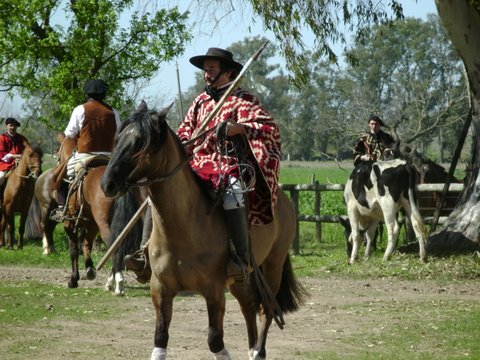Day-1: Buenos Aires
Day-2: Buenos Aires (B)
Day-3: Pampas (B)
Day-4: Buenos Aires - Puerto Madryn (B)
Day-5: Valdes Peninsula (B)
Day-6:Valdes Peninsula (B)
Day-7: Trelew - Ushuaia (B)
Day-8:Tierra del Fuego National Park (B)
Day-9: Tierra del Fuego National Park (B)
Day-10: Ushuaia - El Calafate (B)
Day-11: Perito Moreno Glacier (B)
Day-12: Upsala Glacier (B)
Day-13: El Calafate - Buenos Aires (B)
Day-14: Buenos Aires (B)
End of services
ARGENTINE PATAGONIA ITINERARY
Day-1: Buenos Aires
Arrival in Buenos Aires, reception and transfer to the Hotel
Day-2: Buenos Aires (B)
After breakfast, a half day city tour. Option of a dinner and Tango Show at La Esquina Carlos Gardel, the foremost tango house in Buenos Aires.
Day-3: Pampas (B)
Full day Fiesta Gaucha Excursion, visiting a typical "estancia" or Ranch, in the one of the most fertile and natural prairies of the world, the Argentine. It is most famous for its meat and cereal production.
Day-4: Buenos Aires - Puerto Madryn (B)
After breakfast, flight to Trelew. This city is a part of the coast corridor formed also by the cities of Trelew, Gaiman, Rawson and West San Antonio, the entire region is characterized by the long beaches and its big marine fauna.
Day-5: Valdes Peninsula (B)
Full day excursion to the Peninsula Valdes, a site of global significance for the conservation of marine mammals. It is home to an important breeding population of the endangered Southern Right Whale as well as important breeding populations of southern elephant seals and southern sea lions.
Day-6:Valdes Peninsula (B)
Excursion to Punta Tombo penguin colony, the largest Magellan penguin colony in the world. Penguins first arrive in September and up to mid March but the best season to see them is after November, once the babies are born. This tour is followed by a visit to the welsh colony at Gaiman.
Day-7: Trelew - Ushuaia (B)
Transfer to the airport for the flight to Ushuaia, southernmost city in the world, on the shores of the Beagle Channel. The Beagle Channel follows the southern extreme of Tierra del Fuego.
Day-8:Tierra del Fuego National Park (B)
Excursion to the Tierra del Fuego National Park. Located in south-western Tierra del Fuego province, over the borderline with Chile, this National Park is the southernmost example of the Andean - Patagonian forest. It is a sub-Antarctic forest covering the region up to 600m above sea level, has a surface of 63.000 hectares and is home to the white cauquenes, black eye browed albatross, the diving petrel and a rare kind of otter named chungungo.

Day-9: Tierra del Fuego National Park (B)
After breakfast, excursion to the north of Ushuaia for a visit to Lago Escondido and Lago Fagnano.
Day-10: Ushuaia - El Calafate (B)
After breakfast, transfer to the airport for the flight to El Calafate, site of the incredible Perito Moreno Glacier, one of the most dramatic natural sites left on earth. It is situated not too far from the Chilean border in the south west of Argentinean the shore of Lago Argentino, where the lake is very narrow.
Day-11: Perito Moreno Glacier (B)
Full day excursion to the Perito Moreno Glacier, the largest advancing glacier in the world. Walk along footpaths and balconies to reach this incredible phenomenon.
Day-12: Upsala Glacier (B)
Boat trip to visit the Upsala, Onelli and Spegazzini Glaciers one after another.
Day-13: El Calafate - Buenos Aires (B)
After breakfast, transfer to the airport for the return flight to Buenos Aires and accommodation at the Castelar Hotel.
Day-14: Buenos Aires (B)
After breakfast, transfer to the airport for your return flight home.
End of services